Author: Lacie, Bitget Wallet Researcher
I. Introduction: The "Payment Gap" Between Web2 and Web3
The current digital ecosystem is being torn apart by the inherent conflict between Web2 and Web3. On the one hand, Web2's convenient payment methods (such as Apple Pay and WeChat Pay) are firmly locked within a "walled garden" by centralized platforms and geographical boundaries; on the other hand, while Web3 promises a globally open and permissionless financial future, it has become a "technological island" that deters mainstream users due to its drastic price fluctuations and complex user experience.
The gap between "convenience" and "openness" has long burdened Web3 with the labels of "difficult to implement" and "speculative hype." Against this backdrop, an open protocol called x402 has come into view. Its proposed solution is quite novel: instead of starting from scratch, it attempts to revitalize a 26-year-old underlying internet standard—HTTP 402 (Payment Required).
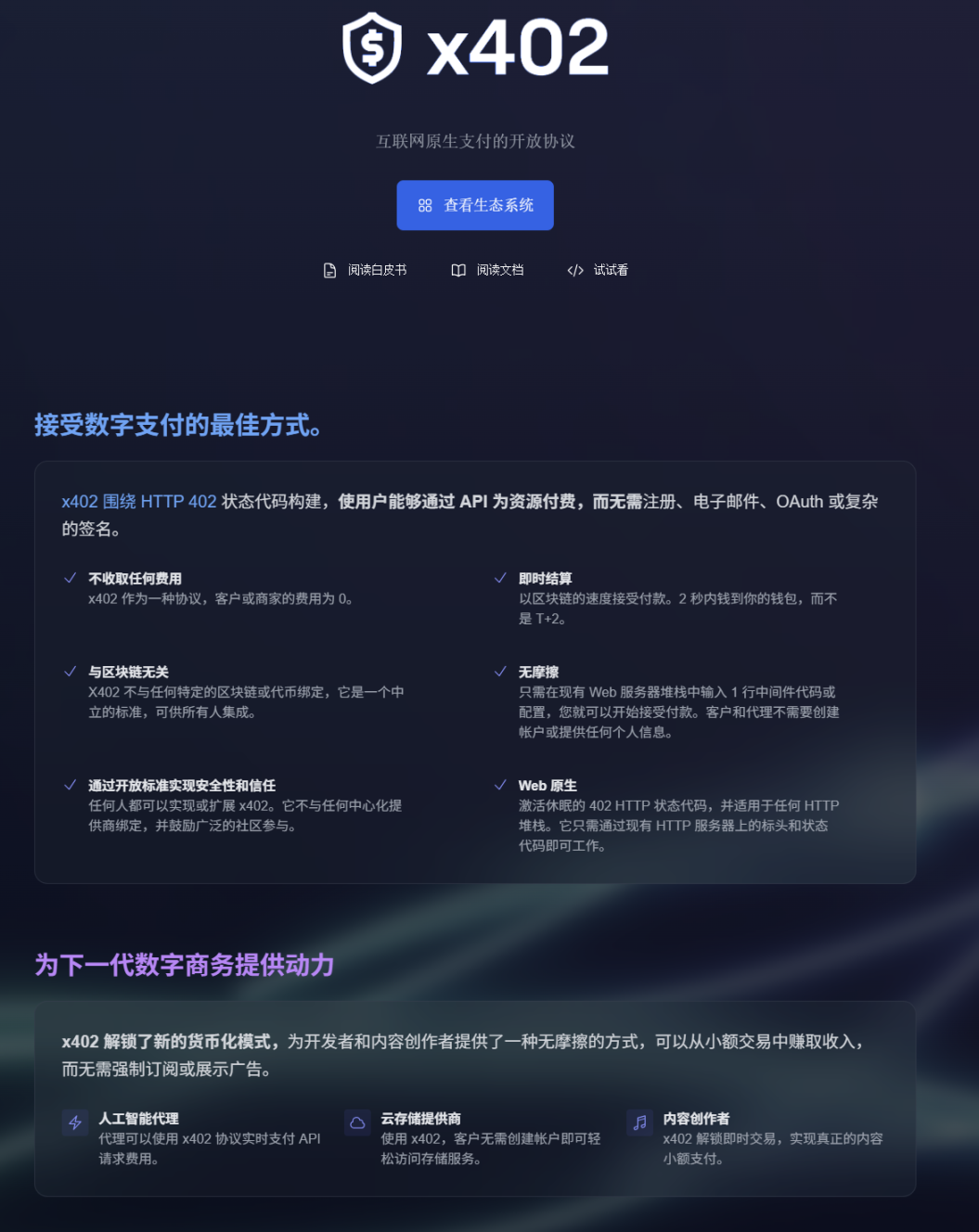
Image: X402 official website homepage introduction image
Source: x402 official website (https://www.x402.org/)
Can this "reactivation" of the underlying internet protocol standards be the key to bridging the aforementioned gap? Does it herald the birth of a native, open Web payment layer that will fundamentally reshape the way value flows on the internet? Bitget Wallet will take you through an in-depth analysis of this in this article.
II. The Belated Breakthrough: What is x402, and why is it only now "going viral"?
x402 is an open protocol developed and open-sourced by Coinbase in May 2025. Its core goal is to revitalize the long-unused HTTP 402 status code, transforming it into an internet-native, permissionless payment mechanism, ultimately establishing a channel between Web2 applications and Web3 value networks.
However, an interesting phenomenon is that the x402 protocol was launched as early as May, but only suddenly became popular after five months of silence. In fact, the 402 status code itself is not a "new invention" in the crypto world, but a reserved code in the HTTP protocol in the 1990s.
So why has an "old standard" and a "not-so-new" protocol only recently sparked heated discussions in the market? The table below outlines the key timelines from the birth of x402 to its explosive popularity, which helps us understand the facts behind this "delayed explosion."
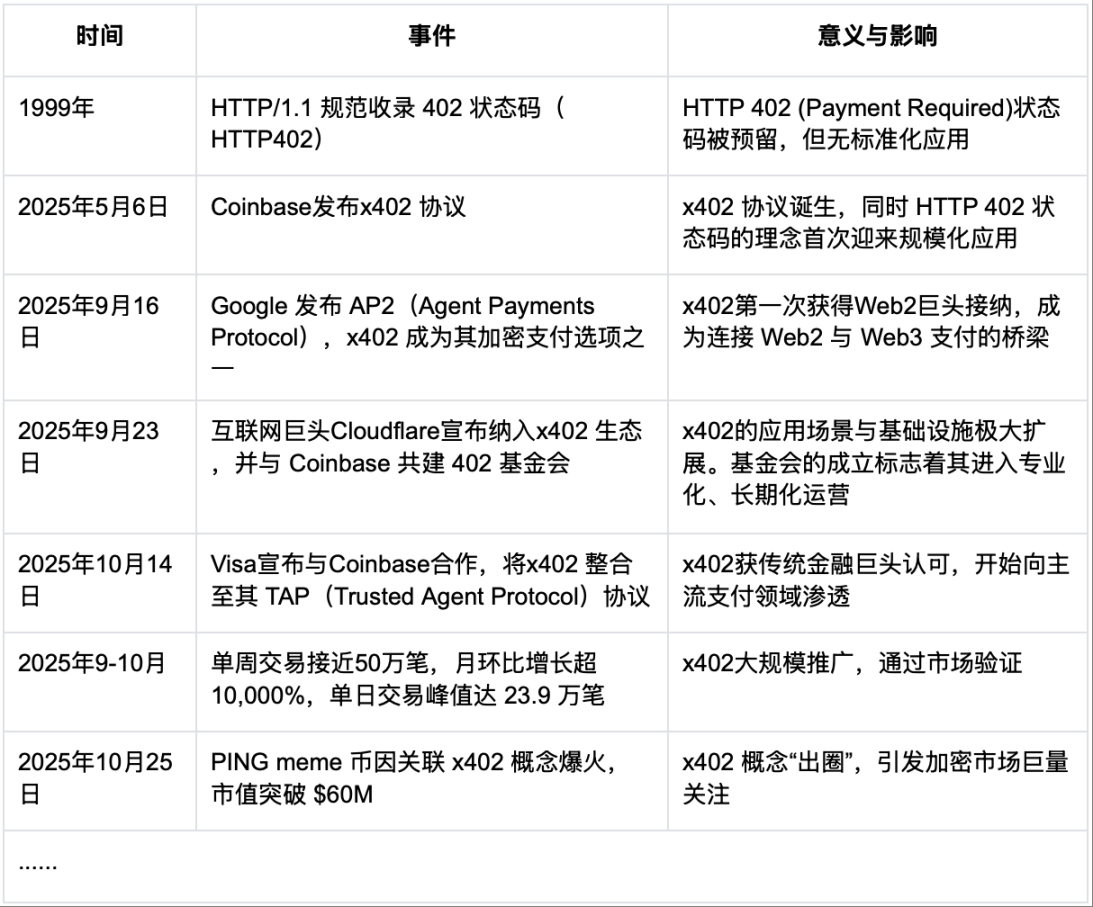
Table: Timeline of the Birth and Application of x402 (as of October 28, 2025)
Data source: Bitget Wallet, compiled from publicly available data (transaction data from x402scan).
As shown in the timeline above, the evolution path of x402 reveals the following key facts:
- First, x402 is a modern application based on the HTTP 402 status code from 1999, which was "shelved" for a long time due to a lack of application scenarios.
- Second, the x402 protocol was initiated by Coinbase and quickly gained support and integration from Web2 giants such as Google, Cloudflare, and Visa within a few months.
- Third, although the protocol has been released for several months, what really made it "go viral" was the recent surge in Meme coin's price by riding the x402 concept.
In short, the current popularity of x402 is the result of a combination of technological vision (AI agent payments) and speculative frenzy (meme-driven). But setting aside the market noise, we should focus more on its technological core—how exactly does it work?
III. Unlocking and Internalizing: How to activate a dormant HTTP 402?
To understand x402, we must turn our attention to the 1990s. The internet uses the HTTP (Hypertext Transfer Protocol) to transmit information between clients and servers. HTTP defines a series of response status codes to represent specific functions, such as the well-known "404 Not Found" or "200 OK" (request successful).
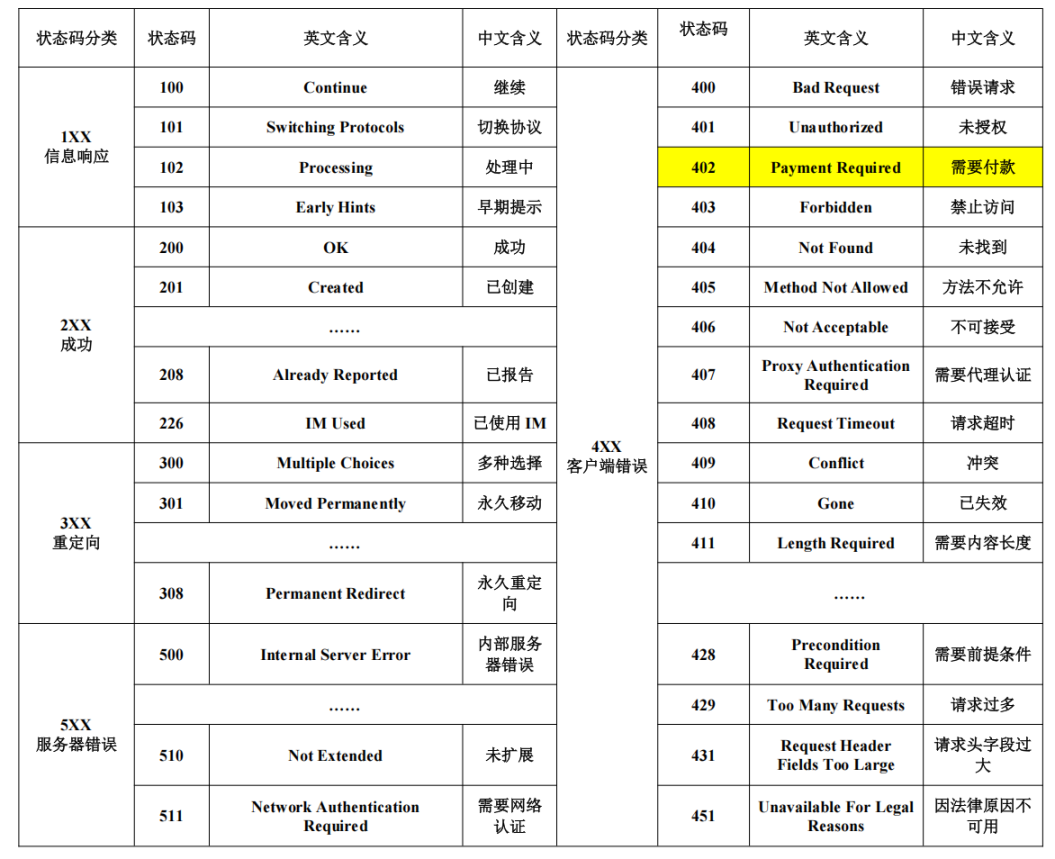
Table: Summary Table of HTTP Status Codes
Data source: Bitget Wallet (compiled)
Within this vast codebase, the 402 (Payment Required) status code stands out. From its inception, it envisioned a protocol-native micropayment method, aiming for instant payments that were "seamlessly seamless, like loading an image"—without intermediaries or delays. However, as the internet economy shifted towards advertising, platforms, and complex credit card forms, the 402 status code's concept was shelved, and the standard has never been widely adopted.
The x402 was introduced precisely to "re-encapsulate" the value of the 402 status code. Its workflow is logically quite ingenious:
- When a user requests a paid resource, the server no longer returns a "redirect" instruction (leading to the subscription page), but instead directly returns a 402 status code. This response contains all the key information needed to complete the payment: the receiving address, the payment amount, the supported blockchain network (such as Base, Polygon, etc.), and the currency type (such as USDC).
- Clients that support x402 (such as browser plugins or Web3 wallets) will automatically translate this 402 request into a payment prompt upon receiving it. The user simply clicks to confirm. The wallet then completes the stablecoin payment via the efficient L2 network and notifies the server upon transaction confirmation. The server verifies receipt and immediately unlocks the content for the user.
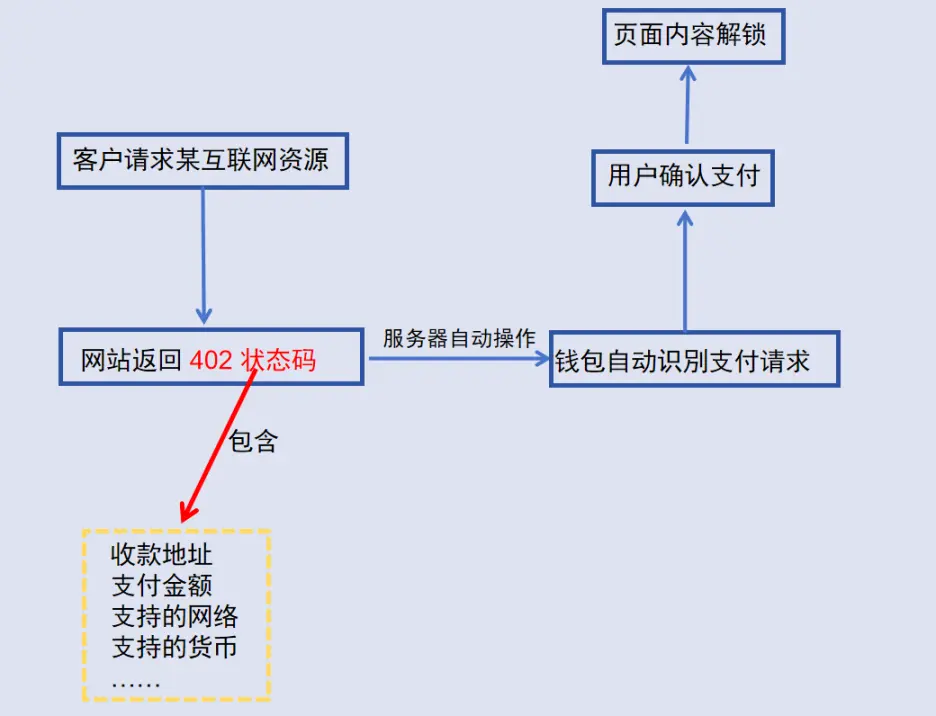
Figure: x402 Workflow Diagram
Source: Compiled by Bitget Wallet
The entire process internalizes payment as part of the HTTP protocol, making it a native browser interaction, just like loading an image or accessing a non-existent page. Essentially, it's the most fundamental communication layer of the internet, with a built-in native "value settlement" function, truly enriching the underlying internet transmission protocols that have existed for over 20 years at the application level.
IV. The time is ripe: Why now?
A reasonable question is: the HTTP 402 standard has existed for 26 years, so why has it only now finally had the opportunity to be implemented through x402? The answer lies in the fact that the "three essential elements" of supply, demand, and catalyst have been present simultaneously.
First, there's the explosive growth on the demand side. The "machine economy," represented by AI agents, is rapidly emerging. AI needs to autonomously and frequently call upon the services and data of other AI or APIs. This automated machine-to-machine (M2M) communication combined with cross-platform micro-payments is something the traditional credit card system cannot support. x402 embeds payments into HTTP requests, perfectly meeting this essential need for "fine-grained" payments based on API calls.
Secondly, there's the technological maturity on the supply side. The infrastructure of the Web3 world is vastly different now. The "digital cash track" missing when the 402 standard was conceived has now been filled by Layer 2, high-performance public chains, and widely circulated stablecoins. The near-instantaneous confirmation and extremely low cost they bring make native internet micropayments economically possible.
Finally, strong advocates are the key catalysts. Coinbase open-sourced the protocol specifications, while Google and Visa endorsed it, and infrastructure giants like Cloudflare jointly launched the x402 Foundation. All these forces worked together to promote x402 as a new "open internet standard," which greatly lowered the integration barrier and accelerated the formation of the ecosystem.
It was precisely during this window of opportunity where technology (supply) and demand (AI) converged, coupled with the impetus (catalyst) from industry giants, that x402 seized the opportunity of infrastructure readiness and transformed from a dormant concept into a real-world application.
V. Singularity and Reefs: The Imagination and Triple Challenges of x402
As described in the x402 white paper (as shown in the diagram below): The most direct application of the x402 protocol is opening the door to the "machine economy" for AI agents. In the future, AI agents will undoubtedly become major participants in the internet. This native, programmable payment protocol, x402, naturally aligns with the economic needs of M2M (machine-to-machine). It allows an AI agent to autonomously call another AI's API service and automatically pay a fee of $0.0x through x402, without human intervention or pre-payment, greatly reducing friction costs between services.
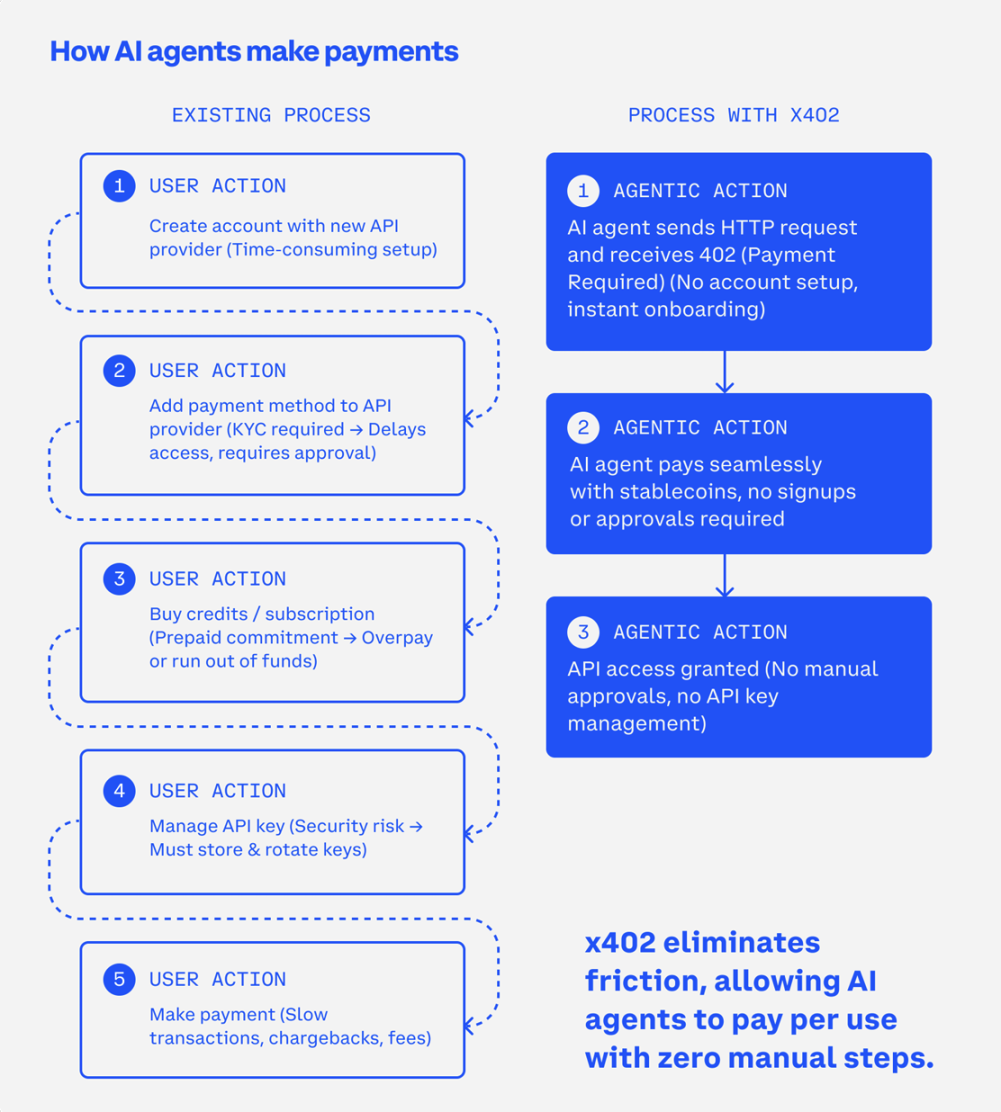
Figure: Comparison of existing intelligent agent payment process and x402 pay-per-use method
Data source: x402 White Paper
Its deeper significance lies in the fact that the x402 header allows an HTTP request to simultaneously possess the dual attributes of "data transmission" and "value transmission." This is the first time that the information protocol since the birth of the Internet has truly incorporated the dimension of "value," and at the application level, it has the potential to truly revolutionize the traditional Web system that has been in use for more than 20 years.
At the same time, this may answer a long-standing pain point for Web3: how can the crypto world empower entities and change the world? For a long time, the crypto world has been criticized for lacking truly mainstream applications, and x402 may become such a singularity—it is not starting from scratch, but attempting to "inject" the value settlement capabilities of Web3 into the vast ecosystem of Web2, becoming a true bridge connecting the two worlds—this is also the underlying logic behind the entire protocol being sought after and hotly debated by countless people.
However, behind the optimistic vision, the challenges facing the x402 are equally undeniable.
First, there are underlying concerns stemming from within the HTTP protocol itself. HTTP 402 remains a "non-standardized" reserved code. As shown in MDN Web Docs (a developer documentation repository), it is defined as "reserved but undefined." This means it hasn't been fully adopted by mainstream web standards, leading to compatibility issues with underlying protocols. Therefore, current implementations of x402 largely rely on "custom HTTP headers" like X-PAYMENT, rather than the true standard 402 status code, casting a shadow over its long-term standardization.
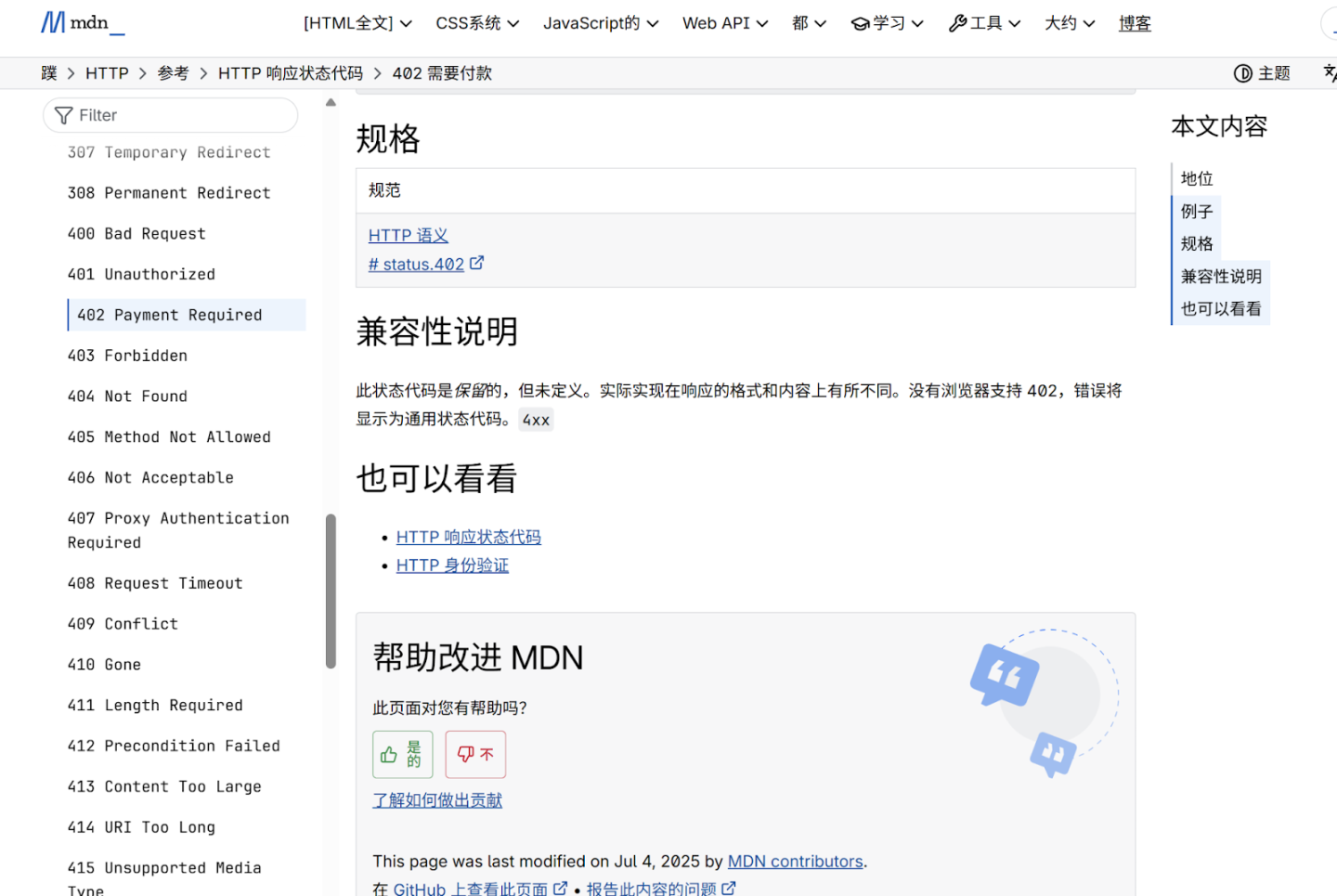
Image: The HTTP 402 status code has been identified as having compatibility issues by the developer documentation library.
Source: MDN Web Docs
Secondly, the subsequent attitudes of traditional internet giants remain to be seen. Although giants like Google have announced their acceptance of this protocol within the AI framework, x402's advocacy of "bypassing platforms and peer-to-peer payments" essentially stands in opposition to the internet giants who currently profit from "walled gardens" and payment commission models. The combination of x402 and AI Agent is more like a "declaration of war" against the traditional internet ecosystem—whether the giants genuinely accept it or merely use it temporarily remains to be seen.
Finally, and most alarmingly, is the potential backlash from the speculative bubble. Since the x402 protocol itself hasn't issued any tokens, all tokens currently associated with it (such as PING) are experimental memes. While the meme craze has objectively boosted x402's popularity, it also raises serious questions: will this movement fall into a false boom fueled by speculative narratives, ultimately undermining genuine technological ideals when the bubble bursts? This is a persistent dilemma the crypto world struggles to escape. (The image below shows the x402 ecosystem.)
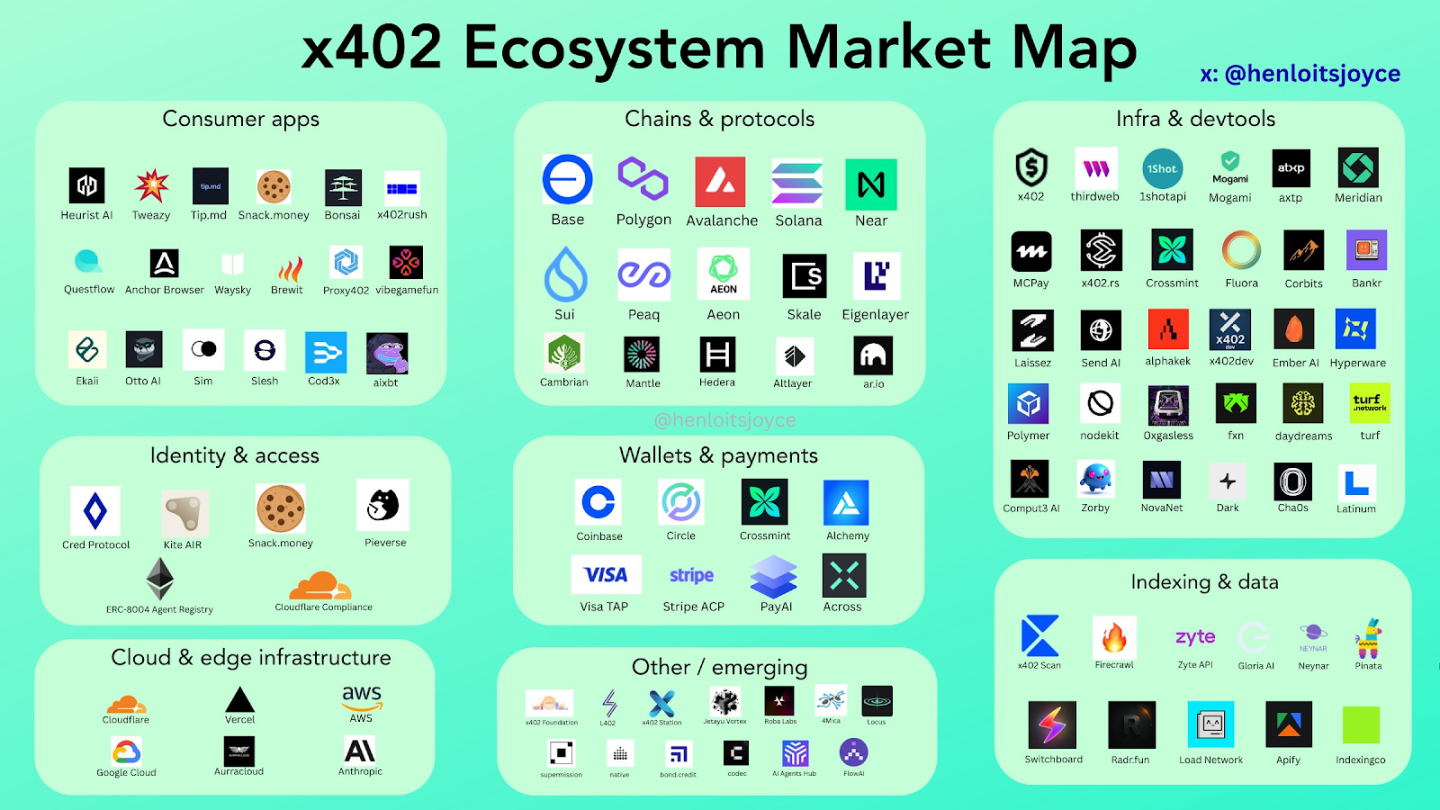
Image: x402 Ecological Overview
Source: X @henloitsjoyce
VI. Conclusion: Amidst the clamor, what is the true value?
x402 offers a highly pragmatic solution for AI Agent payments—it doesn't require users to abandon their existing internet infrastructure, but rather attempts to complete the crucial upgrade of "payment" at the most fundamental protocol level. Ironically, looking back at the entire development of x402, what truly propelled it into the mainstream wasn't its ingenious technical concept, but rather the speculative frenzy surrounding Meme Coin in late October. This means that many current analyses of x402's disruptive potential are based on "seeing the bubble first, then working backward to deduce its significance."
The current x402 craze is less driven by technological breakthroughs and more by speculative narratives. This raises a core question: Is x402 truly a milestone in the convergence of Web3 and Web2, a real singularity propelling the internet into a "value layer," or is it merely a lifeline grasped by the crypto market in its search for the next "100x narrative"?
The answer still needs time to be verified. However, the "native HTTP value layer" concept indicated by x402 has provided a profound direction for Web3 to empower Web2. This kind of thinking about the future is far more valuable than any temporary market hype.







